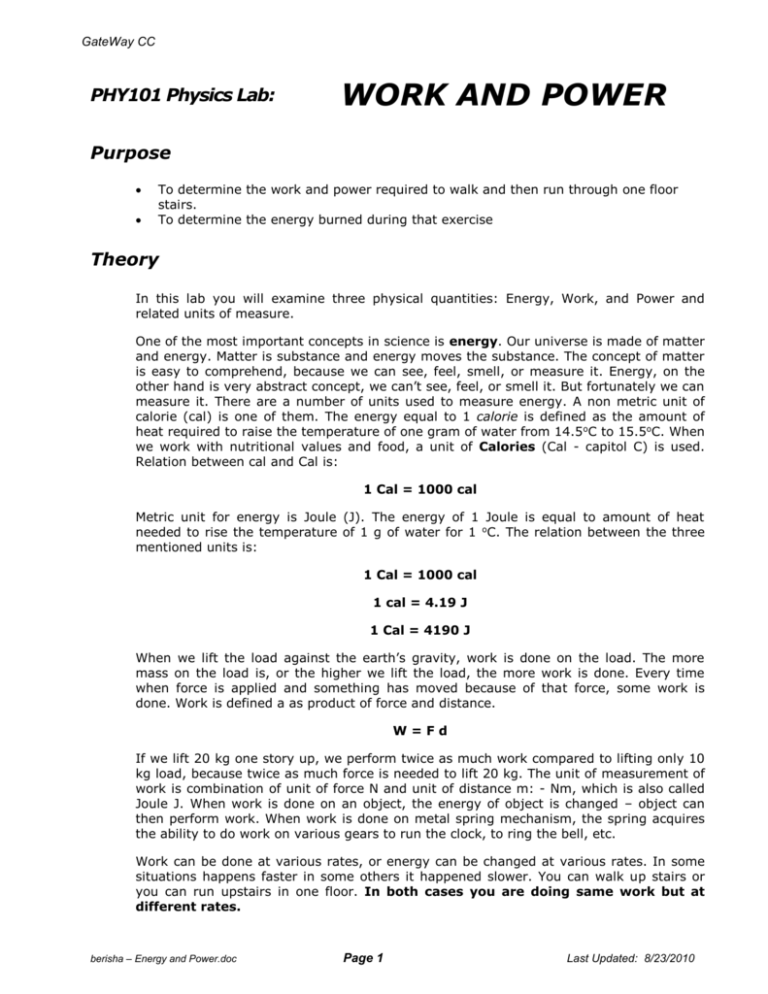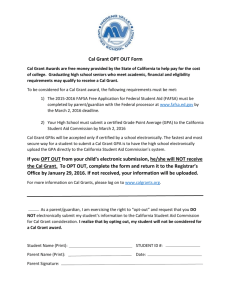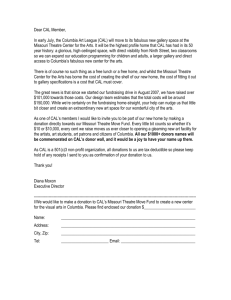Energy Work and Power Lab
advertisement

GateWay CC PHY101 Physics Lab: WORK AND POWER Purpose To determine the work and power required to walk and then run through one floor stairs. To determine the energy burned during that exercise Theory In this lab you will examine three physical quantities: Energy, Work, and Power and related units of measure. One of the most important concepts in science is energy. Our universe is made of matter and energy. Matter is substance and energy moves the substance. The concept of matter is easy to comprehend, because we can see, feel, smell, or measure it. Energy, on the other hand is very abstract concept, we can’t see, feel, or smell it. But fortunately we can measure it. There are a number of units used to measure energy. A non metric unit of calorie (cal) is one of them. The energy equal to 1 calorie is defined as the amount of heat required to raise the temperature of one gram of water from 14.5 oC to 15.5oC. When we work with nutritional values and food, a unit of Calories (Cal - capitol C) is used. Relation between cal and Cal is: 1 Cal = 1000 cal Metric unit for energy is Joule (J). The energy of 1 Joule is equal to amount of heat needed to rise the temperature of 1 g of water for 1 oC. The relation between the three mentioned units is: 1 Cal = 1000 cal 1 cal = 4.19 J 1 Cal = 4190 J When we lift the load against the earth’s gravity, work is done on the load. The more mass on the load is, or the higher we lift the load, the more work is done. Every time when force is applied and something has moved because of that force, some work is done. Work is defined a as product of force and distance. W=Fd If we lift 20 kg one story up, we perform twice as much work compared to lifting only 10 kg load, because twice as much force is needed to lift 20 kg. The unit of measurement of work is combination of unit of force N and unit of distance m: - Nm, which is also called Joule J. When work is done on an object, the energy of object is changed – object can then perform work. When work is done on metal spring mechanism, the spring acquires the ability to do work on various gears to run the clock, to ring the bell, etc. Work can be done at various rates, or energy can be changed at various rates. In some situations happens faster in some others it happened slower. You can walk up stairs or you can run upstairs in one floor. In both cases you are doing same work but at different rates. berisha – Energy and Power.doc Page 1 Last Updated: 8/23/2010 GateWay CC The rate at which the energy is changed, or work is done is called Power P. P = work done/ time interval The unit of power is: Joule/second = Watt J/s = W Another example to illustrate the concept of power is with 1 liter of gasoline. A liter of gasoline can do certain amount of work, but power produced when we burn can be any amount, depending how fast it is burned. When force F is applied to an object with mass m, over the distance d, that is parallel to the direction of the force, then work done is: Work = Force * Distance Pre Lab Questions 1.) Two people of the same mass climb the same flight of stairs. The first person climbs the stairs in 25 seconds. The second person takes 35 seconds. Which person does the most work? Which person expends the most power? Explain your answers. 2.) A box that weighs 1000 Newtons is lifted a distance of 20.0 meters straight up by a rope and pulley system. The work is done in 10.0 seconds. What is the power developed in watts and kilowatts? 3.) A person of mass 64 kg climbs up a ladder to a height of 5.0 meters. a.) What work does the person do? b.) What is the increase in the gravitational potential energy of the person at this height? c.) Where does the energy come from to cause this increase in P.E. (Potential Energy). 4.) A 60.0 kg shell is shot from cannon to a height of 400 meters. a.) What is the gravitational potential energy of the shell when it is at this height? b.) What is the change in potential energy of the shell when it falls to a height of 100 meters? 5.) A person has a mass of 45 kg and is moving with a velocity of 10.0 m/s. a.) Find the person’s kinetic energy. b.) The person’s velocity becomes 5.0 m/s. What is the kinetic energy of the person? c.) What is the ratio of the kinetic energy in these two cases? 6.) A 15.0 kg object is moving with a velocity of 17.5 m/s. A force of -50.0 N acts on the object and its velocity becomes 3.20 m/s. What is the displacement of the object while the force acts? berisha – Energy and Power.doc Page 2 Last Updated: 8/23/2010 GateWay CC 7.) A 15.0 kg model plane flies horizontally at 12.5 m/s. a.) Calculate its kinetic energy. b.) The plane goes into a dive and levels off 20.4 meters closer to the Earth. How much potential energy did it lose during the dive? c.) How much kinetic energy did the plane gain during the dive? d.) What is its new kinetic energy? e.) Neglecting frictional effects, what is its new horizontal velocity? Procedure For Part I – Determine the power done and energy burned by walking up stairway for one floor: 1. Each group of students should consist of two students: student A, and student B. Both students will perform the experiment in the stairway at the end of the hallway, toward the exit way. Using a bathroom scale students measure their mass in kilograms and calculate their weight – force in Newton’s (Weight = Mass x Gravity). If the mass is measured in pound – change that into kilograms (1 lb = 0.4536 kg). Record the mass and the weight of each student in table. 2. After these measurements, students will measure the vertical height of the stairs. Measure the height of one step of the staircase and multiply by the number of steps. The height should be converted into meters and recorded in table. 3. Set the stopwatch to zero. First student will walk upstairs at the normal paste. Start the stopwatch when both feet of the student have left the ground floor and stop the watch when both feet are on the top floor. Record the measured time in table. 4. Second student will starts walking upstairs and first student should measure the time required to walk up to second floor. Time should be recorded in seconds. Calculate the work accomplished for each student: Work =Student Weight(N) x Vertical height of staircase(m) = F d Calculate how fast is this work done - Power P = Work/Time measured Calculate the energy burned by walking up stairs. Average time should be used as Time measured. E = Work Calculate how many Calories are burned by each student by walking up stairs. Calories = E/1000 Each student should walk up stairways 4 times and record the average time. For Part II – Determine the power done and energy burned by running up stairway one floor: Repeat steps from part I by running up stair way one floor. berisha – Energy and Power.doc Page 3 Last Updated: 8/23/2010 GateWay CC Data Table Part I: Walking upstairs Units Mass = m kg Weight = W N Vertical height of staircase m Average walking time sec Work J Power = P W Energy in Joules J Energy in cal cal Food Energy in Cal Cal Student A 1 2 3 4 Student B Av 1 2 3 4 Av Part II: Running upstairs Units Mass = m kg Weight = W N Vertical height of staircase m Average walking time sec Work J Power = P W Energy in Joules J Energy in cal cal Food Energy in Cal Cal berisha – Energy and Power.doc Student A 1 2 3 Page 4 4 Student B Av 1 2 3 4 Av Last Updated: 8/23/2010 GateWay CC Analysis/Questions 1. Is there a difference in power done walking and power done running upstairs and why? 2. Is there a limit how high the student power done can go? Explain. 3. Normally slower moving person would develop less power then faster moving student. Can you describe the situation in which a slower moving student can develop more power then faster moving student. 4. If a student had a single peanut before this lab, how many times would a student have to run upstairs in order to burn the energy from a single peanut? A single peanut has the energy of 5 Calories = 5000 cal = 20.95 kJ. 5. Which requires more work: lifting a 50 kg box vertically for distance of 2 m, or lifting a 25 kg box vertically for a distance of 4 meters. Reaction Time Measurement One of the main sources of error in this experiment is time measurement. Reaction time is the ability to respond quickly to an event e.g. student starts walking or running. Simple reaction time is the time taken between a stimulus and movement e.g., runs start. Go to: http://www.gwc.maricopa.edu/class/phy101/Flash/reaction%20time.htm to determine your own reaction time. Please include the results of your reaction time measurement in your lab report. berisha – Energy and Power.doc Page 5 Last Updated: 8/23/2010






